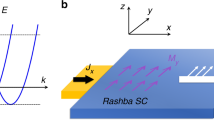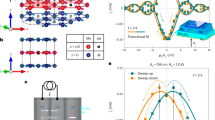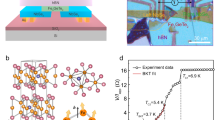Abstract
In general, conventional superconductivity should not occur in a ferromagnet, though it has been seen in iron under pressure1. Moreover, theory predicts that the current is always carried by pairs of electrons in a spin singlet state2, so conventional superconductivity decays very rapidly when in contact with a ferromagnet, which normally prohibits the existence of singlet pairs. It has been predicted that this rapid spatial decay would not occur if spin triplet superconductivity could be induced in the ferromagnet3,4. Here we report a Josephson supercurrent through the strong ferromagnet CrO2, from which we infer that it is a spin triplet supercurrent. Our experimental set-up is different from those envisaged in the earlier predictions, but we conclude that the underlying physical explanation for our result is a conversion from spin singlet pairs to spin triplets at the interface. The supercurrent can be switched with the direction of the magnetization, analogous to spin valve transistors, and therefore could enable magnetization-controlled Josephson junctions.
This is a preview of subscription content, access via your institution
Access options
Subscribe to this journal
Receive 51 print issues and online access
$199.00 per year
only $3.90 per issue
Buy this article
- Purchase on Springer Link
- Instant access to full article PDF
Prices may be subject to local taxes which are calculated during checkout



Similar content being viewed by others
References
Shimizu, K. et al. Superconductivity in the non-magnetic state of iron under pressure. Nature 412, 316–318 (2001)
Tinkham, M. Introduction to Superconductivity 2nd edn (McGraw-Hill, New York, 1996)
Bergeret, F. S., Volkov, A. F. & Efetov, K. B. Long-range proximity effects in superconductor-ferromagnet structures. Phys. Rev. Lett. 86, 4096–4099 (2001)
Bergeret, F. S., Volkov, A. F. & Efetov, K. B. Odd triplet superconductivity and related phenomena in superconductor-ferromagnet structures. Rev. Mod. Phys. 77, 1321–1373 (2005)
Iosad, N. N. et al. Properties of (Nb0.35, Ti0.15)xN1-x thin films deposited on silicon wafers at ambient substrate temperature. J. Appl. Phys. 88, 5756–5759 (2000)
Coey, J. M. D. & Venkatesan, M. Half-metallic ferromagnetism: example of CrO2 . J. Appl. Phys. 91, 8345–8350 (2002)
Ryazanov, V. V. Josephson superconductor-ferromagnet-superconductor π-contact as an element of a quantum bit (experiment). Phys. Usp. 42, 825–827 (1999)
Kontos, T., Aprili, M., Lesueur, J. & Grison, X. Inhomogeneous superconductivity induced in a ferromagnet by proximity effect. Phys. Rev. Lett. 86, 304–307 (2001)
Korotin, M. A., Anisimov, V. I., Khomskii, D. I. & Sawatzky, G. A. CrO2: a self-doped double exchange ferromagnet. Phys. Rev. Lett. 80, 4305–4308 (1998)
Gupta, A., Li, X. W. & Xiao, G. Magnetic and transport properties of epitaxial and polycrystalline chromium dioxide thin films (invited). J. Appl. Phys. 87, 6073–6078 (2001)
Soulen, R. J. Jr et al. Measuring the spin polarization of a metal with a superconducting point contact. Science 282, 85–88 (1998)
Parker, J. S., Watts, S. M., Ivanov, P. G. & Xiong, P. Spin polarization of CrO2 at and across an artificial barrier. Phys. Rev. Lett. 88, 196601 (2002)
Spinu, L., Srikanth, H., Gupta, A., Li, X. W. & Xiao, G. Probing magnetic anisotropy effects in epitaxial CrO2 thin films. Phys. Rev. B 62, 8931–8934 (2000)
Kadigrobov, A., Shekhter, R. I. & Jonson, M. Quantum spin fluctuations as a source of long-range proximity effects in diffusive ferromagnet-superconductor structures. Europhys. Lett. 54, 394–400 (2001)
Leggett, A. J. A theoretical description of the new phases of liquid 3He. Rev. Mod. Phys. 47, 331–414 (1975)
MacKenzie, A. P. & Maeno, Y. The superconductivity of Sr2RuO4 and the physics of spin-triplet pairing. Rev. Mod. Phys. 75, 657–712 (2003)
Saxena, S. S. et al. Superconductivity on the border of itinerant-electron ferromagnetism in UGe2 . Nature 406, 587–592 (2000)
Giroud, M., Courtois, H., Hasselbach, K., Mailly, D. & Pannetier, B. Superconducting proximity effect in a mesoscopic ferromagnetic wire. Phys. Rev. B 58, R11872–R11875 (1998)
Petrashov, V. T., Sosnin, I. A., Cox, I., Parsons, A. & Troadec, C. Giant mutual proximity effects in ferromagnetic/superconducting nanostructures. Phys. Rev. Lett. 83, 3281–3284 (1999)
Peña, V. et al. Coupling of superconductors through a half-metallic ferromagnet: Evidence for a long-range proximity effect. Phys. Rev. B 69, 224502 (2004)
Wilhelm, F. K., Zaikin, A. D. & Schön, G. Supercurrent in a mesoscopic proximity wire. J. Low-Temp. Phys. 106, 305–310 (1997)
Eschrig, M., Kopu, J., Cuevas, J. C. & Schön, G. Theory of half-metal/superconductor heterostructures. Phys. Rev. Lett. 90, 137003 (2003)
Li, X. W., Gupta, A. & Xiao, G. Influence of strain on the magnetic properties of epitaxial (100) chromium dioxide (CrO2) films. Appl. Phys. Lett. 75, 713–715 (1999)
Acknowledgements
We thank I. van Dijk, M. G. Flokstra, H. T. Man and S. Russo for stimulating interactions. This work is part of the research programme of the Stichting voor Fundamenteel Onderzoek der Materie (FOM), which is financially supported by the Nederlandse Organisatie voor Wetenschappelijk Onderzoek (NWO). The work at the University of Alabama was supported by the National Science Foundation as part of an MRSEC grant.
Author information
Authors and Affiliations
Corresponding authors
Ethics declarations
Competing interests
Reprints and permissions information is available at npg.nature.com/reprintsandpermissions. The authors declare no competing financial interests.
Rights and permissions
About this article
Cite this article
Keizer, R., Goennenwein, S., Klapwijk, T. et al. A spin triplet supercurrent through the half-metallic ferromagnet CrO2. Nature 439, 825–827 (2006). https://doi.org/10.1038/nature04499
Received:
Accepted:
Issue Date:
DOI: https://doi.org/10.1038/nature04499
This article is cited by
-
Finite-momentum Cooper pairing in proximitized altermagnets
Nature Communications (2024)
-
The superconducting diode effect
Nature Reviews Physics (2023)
-
Long-range skin Josephson supercurrent across a van der Waals ferromagnet
Nature Communications (2023)
-
Symmetry-broken Josephson junctions and superconducting diodes in magic-angle twisted bilayer graphene
Nature Communications (2023)
-
Chiral antiferromagnetic Josephson junctions as spin-triplet supercurrent spin valves and d.c. SQUIDs
Nature Nanotechnology (2023)
Comments
By submitting a comment you agree to abide by our Terms and Community Guidelines. If you find something abusive or that does not comply with our terms or guidelines please flag it as inappropriate.



